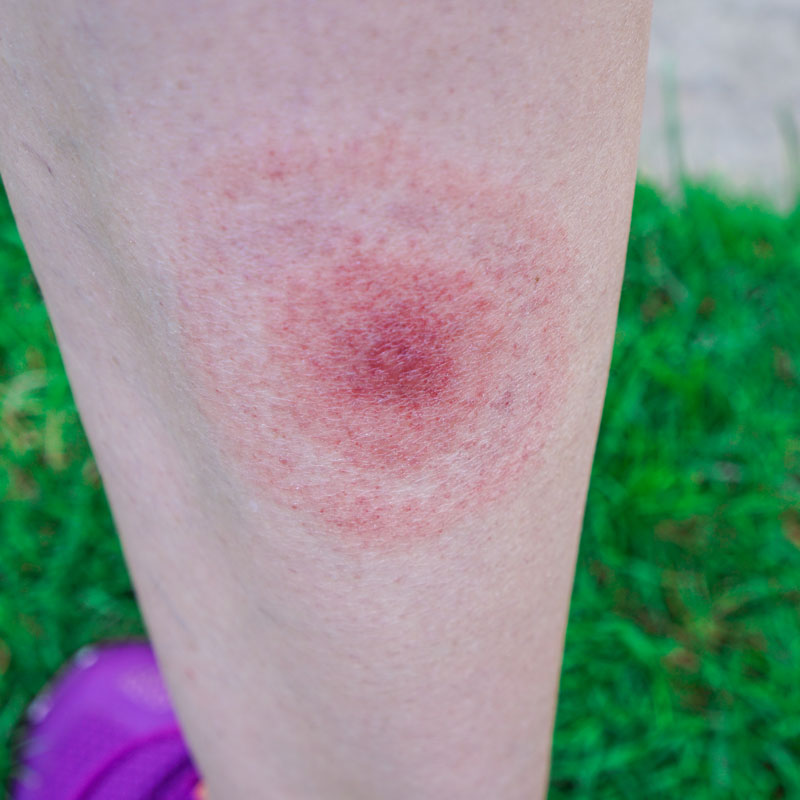Lyme Disease
Platelet Therapy™ for Patients With Lyme Disease
Platelet Therapy™ can alleviate the symptoms and have a significant impact on the bacteria that causes Lyme disease known as Borrelia burgdorferi. Understanding the signs and symptoms of Lyme disease is one of the most crucial aspects of finding appropriate treatment. Lyme disease is the most common vector-borne disease in the United States. Humans become infected when a black-legged tick, commonly called a deer tick, bites them and they become infected. Discover how Platelet Therapy™ can help combat the disease and improve your overall health and well-being.

What Are the Signs and Symptoms of Lyme Disease?
Early signs of and symptoms, 3 to 30 days after a tick bite, may include rash, fever, chills, headache, fatigue, muscle and joint pains and swollen lymph nodes. Later signs and symptoms that may develop are a swollen knee, facial palsy, severe head and neck stiffness, nerve pain and episodes of dizziness. There are three stages of Lyme disease depending on the length in which the bacteria are present in your body.
Learn More About Some of the Signs and Symptoms of Lyme Disease
The rash is the most recognizable feature of Lyme Disease and typically occurs within a day or up to a month after a tick bite. It is often described as having a “bullseye” appearance.
Another common symptom of Lyme disease is a general feeling of lethargy or malaise.
When Lyme disease-causing bacteria enter your joints and muscle, it can cause pain and inflammation. The pain is migratory, and you may feel discomfort in different parts of the body on different days.
Severe headaches and neck stiffness caused by brain and spinal cord inflammation typically begin in the second stage.
Lyme disease can cause fascial palsy, which leads to droopiness in the face. You may also find it challenging to close your eye.
Carditis is inflammation of the heart triggered by Lyme disease bacteria. Symptoms of carditis include dizziness, irregular heartbeat, and fainting.
Infected individuals may feel a constant burning, stabbing, or numbing sensation in their hands and feet.
Lyme disease can make it difficult for individuals to fall asleep or stay asleep. They may also not feel entirely rested after sleeping.

What Role Do Platelets Play in the Body’s Response to Bacteria?
Platelets act like drones in your body, seeking out pathogens and viruses to destroy. Platelets are responsible for initiating our immune response by signaling to the white blood cell once they encounter a virus or pathogen. However, in cases of Autoimmune diseases, a therapeutic concentration of platelets needs to be injected in order for the body to mount a renewed attack against viruses that have been well-established in our body. Platelet Therapy™ has antibacterial qualities that make it effective against borrelia burgdorferi, the bacteria that causes Lyme Disease. According to the scientific literature, this antibacterial effect occurs because of the therapeutic concentration of at least 1.5 Billion platelets per mL injected or greater. These therapeutic concentrations can be achieved and validated with the technology from Platelet Therapy™. This is why patients are experiencing relief from their symptoms from Lyme and other Autoimmune disorders after receiving multiple injections of Platelet Therapy™.
How Can Platelet Therapy™ Help?
By releasing a therapeutic concentration of platelets into the body, your immune system will recognize the increase in platelets and will immediately search out inflammation in your body. Platelets have receptors on them and are sensitive to different proteins that signal to the platelets for their help in fighting inflammation. This type of immune response only happens when Platelet Therapy™ is in the therapeutic concentration. This is why it is important to know if your provider takes into consideration your platelet count as well so they validate the concentration before injection.
Begin Your Lyme Disease Recovery Today
Using your body’s natural immune response is a safe and effective way to treat an invasion of viruses, bacteria, or other pathogens. Lyme disease shouldn’t be ignored, and symptoms can drastically reduce your quality of life. Chronic pain can develop, and early intervention now could potential prevent more severe symptoms to develop.
